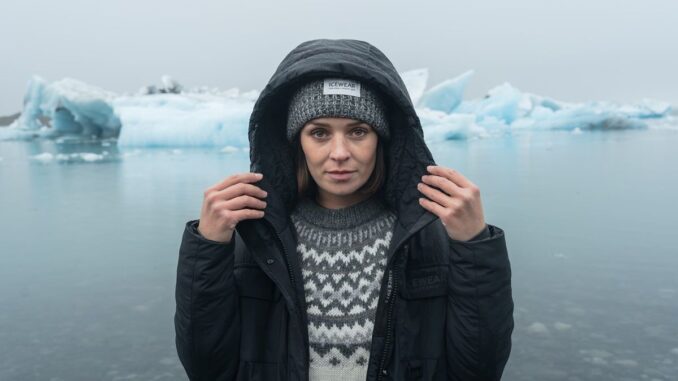
Embody the spirit of more than a millennia of Icelandic adventures with a Sleipnir sweater. The 100% wool knit references the Norse God Odin who descended to earth to mount a Sleipnir when leading fallen Asgard heroes to the heavens.
Icewear began in the village of Hvammstangi in North Iceland, as a small wool factory called Drífa. Using the slogan, “Be warm, be well”, it produced woollen sweaters and other garments in traditional Icelandic patterns, selling them to retailers throughout the country.
In 1988, Ágúst Thor Eiríksson became owner of the company, incorporating variations in colours organic to the wool of Icelandic sheep. This breakthrough design of adding multiple colours to the Icelandic sweater Influenced by the Winter Olympics in Lillehammer in 1994, the product line will expand to include Norwegian-style sweater designs. In 2010 Icewear opened its first concept store on Bankastræti in downtown Reykjavík and two years later in Mýrdal on Iceland’s renowned South Coast. Through its increased physical presence, Icewear is building stronger ties with local craftspeople, while continuing to provide quality homegrown products to local consumers and tourists alike.
The opening of Icewear’s sewing factory in Ásbrú, Reykjanesbær facilitates the production of our non-knitted clothing items, says Eiríksson.
“Our collection is designed for people who love to be outdoors. We’ve got you covered – from technical jackets guaranteed to protect you in extreme conditions to comfortable woollen sweaters perfect for putting on after the sun goes down. While our designers work hard to create pieces that are in line with the latest trends and colours, I’ve made it my mission to ensure our quality controls are robust, our customer service is unbeatable, and our prices are competitive.
“We feel incredibly lucky to work with the woollen fibre of our Icelandic sheep when creating our acclaimed Icelandic wool collection. I am personally fascinated by these hardy creatures whose existence in our harsh environment has led to the remarkable composition of their wool. It is the perfect fibre – breathable, lightweight, water repellent and of course natural. When put in the hands of our Icewear designers and craftspeople it is also turned into something uniquely stylish and functional.”
The Icelanders look after their gods. Vali the Norse God of revenge, Magni the son of Thor and God of strength and Baldur, the God of beauty all now enjoy protected status. As do Goddesses like Dagny Gefnur and Freya, Goddess of love, beauty and health.
A garment which has protected humans for centuries is now protected by human law. The traditional Icelandic sweater – Íslenska Lopapeysan – is now a product name protected by the country’s food and veterinary authority.
Which means that an authentic Icelandic sweater must be made from wool sheared from Icelandic sheep, the wool must be new/virgin and not recycled and it must be handknit in Iceland.
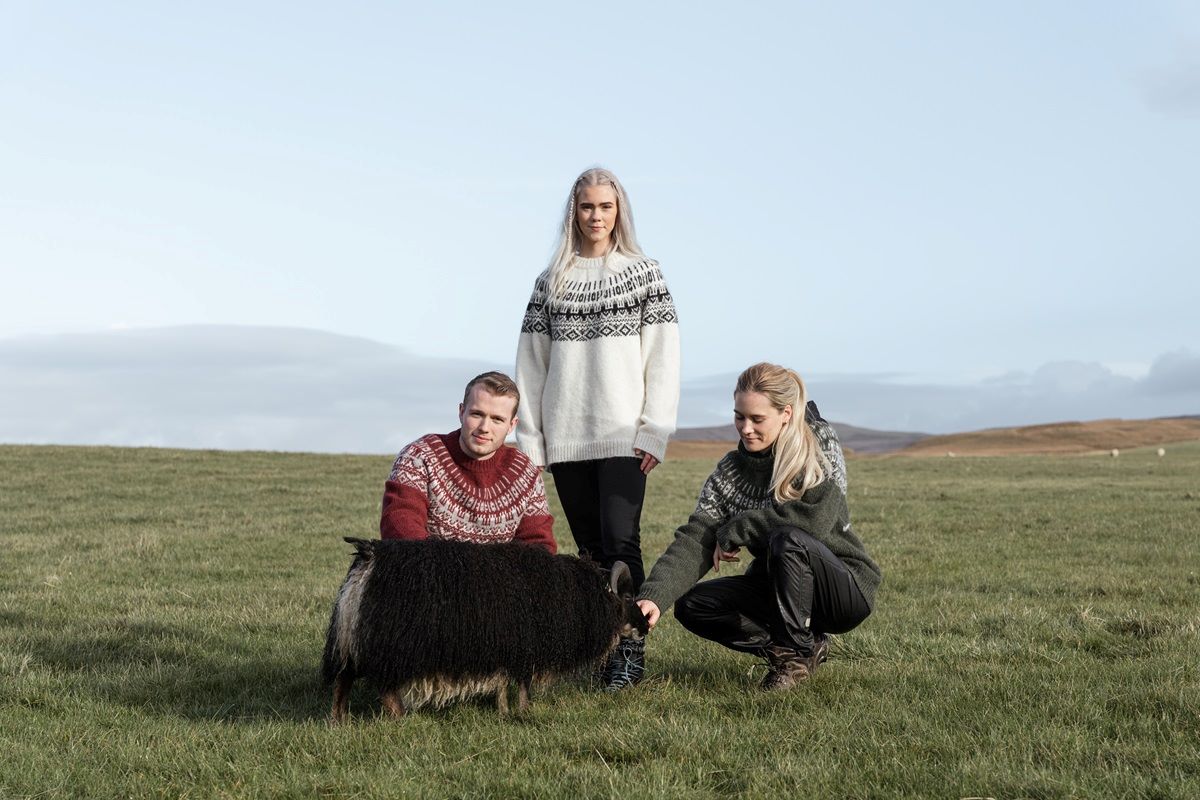
Eiríksson continues:
“The lopapeysa isn’t just a relic from Iceland’s past – it’s still a staple wardrobe item.
“Knitting is taught in schools. Many Icelandic people knit their own sweaters, including some men. Although this is still a primarily female pastime, nobody lets prejudices or stereotypes get in the way when it comes to enjoying the traditional hobby.”
The first immigrants from Norway brought sheep to Iceland. The craft of knitting is mentioned in the first Icelandic Bible, printed in 1584. Knitted clothes have even been used as a means of trade since 1582. A pair of sixteenth century mittens were found during archaeological excavations in Storaborg in southern Iceland.
Knitting is believed to have migrated from England, the Netherlands and Germany at the turn of the sixteenth century. Archaeological excavations have also uncovered evidence of Icelandic knitwear in other parts of Europe. A pair of mittens knitted in Iceland around 1700 were discovered in Copenhagen, Denmark. Icelandic students learn to knit at school as part of their crafts education.
The main difference between Icelandic and Norwegian knitwear is that Norwegian sweaters are often blue, white and red, the pattern is usually a star (sometimes resembling more a flower) and often has dots on the torso.
Icelandic patterns are usually diamond-shaped and zig zag. Icelandic colours are usually sheep colours, so grey, white, black etc but today sweaters are more diverse. Hamar, Gerde, Pétur, Skjaldbreiður, Ásthildur, Elís and Fagradalsfjall are Icewear’s bestsellers.
Wool processing has been a trade in Mosfellsbaer since 1896, previously with the company Álafoss of Iceland until Ístex took over in 1991. Istex buys wool directly from farmers in Iceland and process it into yarns. It is Iceland’s main wool producer, producing seven yarns and knitting pattern book. Yan colours range from Frostbite and Glacier Blue to Milky Way, Rough Sea and Black Sheep.
Iceland’s knitwear industry benefitted from its independence from Denmark in 1944. The lopapeysa was introduced as a new Icelandic tradition and symbol of national identity.
There are several theories about the origin of the patterns. One of them points to the Auður Laxness, the wife of Iceland’s Nobel Laureate in Literature, Halldor Laxness. She was said to be inspired by the design of Inca culture that she saw in a book brough back from his travels.
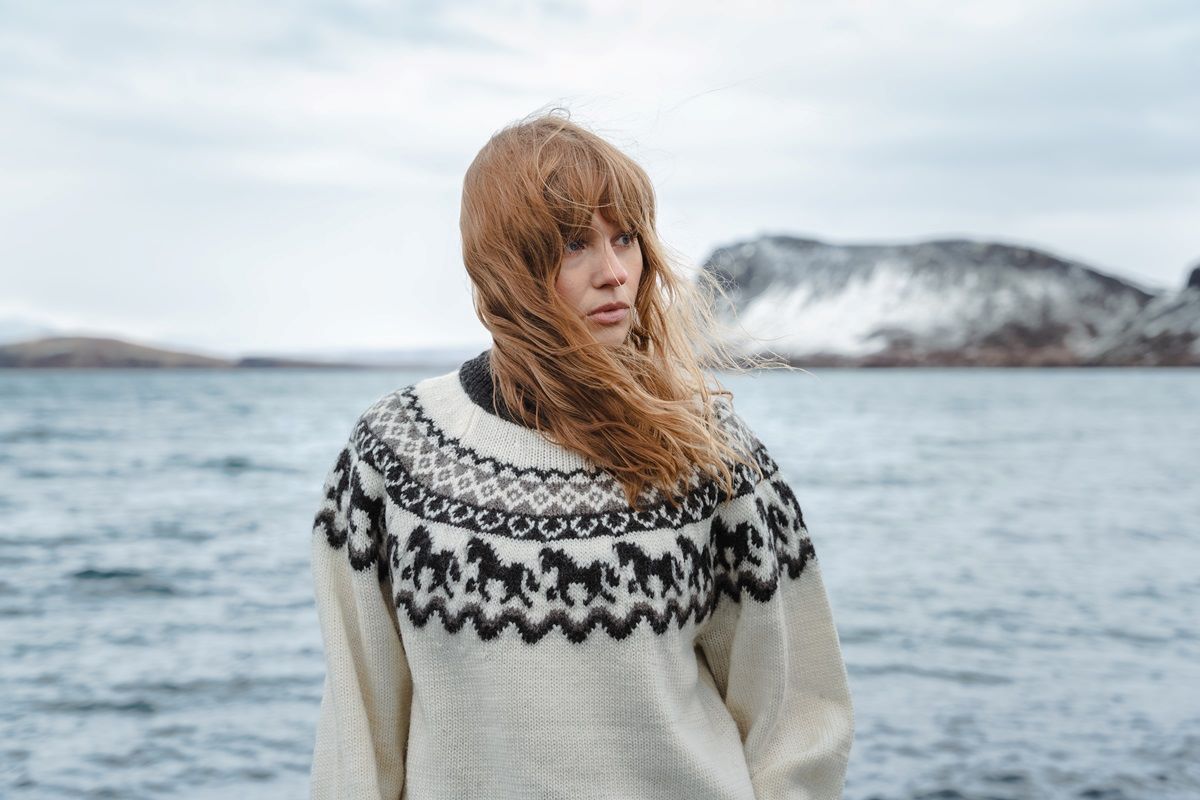
Norwegian patterns were based on the Greenlandic nuilarmiut, traditional formal wear with a beaded collar that covers the shoulders and bust and has brightly patterned geometric designs. Although the origin of the yoke pattern cannot be traced, Icelandic yokes (sometimes with matching cuffs and waist) feature nationalistic symbols like flowers, leaves, snowflakes and horses.
Wool and horse hides soaked in fish oil were the only materials the Icelandic folk had to protect them against whatever the weather threw at them. “Afréttur,” means common grazing land owned by local farmers.
Icelandic wool is characterised by the two parts of the fleece: the “tog”, which is similar to guard hair and “þel”, a type of down hair. The þel is closer to the skin, the hairs are soft, fine, short and springy. The tog is the outer part of the fleece and is made up of long, coarse and shiny hairs. The þel is airy and provides good insulation but the tog is water and moisture repellent. When wool work became a factory industry in the late 19th century, combing and spinning was done by machines. The machines couldn’t separate the þel from the tog so the Icelandic “lopi” or sliver we know today is in fact a mixture of þel and tog.
The Icelandic “vistarband”, a form of serfdom, was abolished around 1900. As a result, labourers moved from rural areas to towns looking for new opportunities and many men went to sea. This greatly increased the demand for comfortable work sweaters that could be made quickly. Faroese sailor sweaters were very popular advertised goods in Iceland around 1900.
The sailor sweater was the wool sweater’s predecessor. Patterns differed from one country to the next and sometimes even from one crew to the next, but they were usually black on a white background. For a long time, the patterns on the foreign sailor sweaters were related to Christian symbols like crosses and stars and were possibly meant for protection. The Icelandic sailor sweaters didn’t have a pattern. The black and white appearance was achieved by mixing two or three colours together that created a kind of speckled appearance.
The main wool yarns are Lettlopi, Alafosslop, Plotilopi, Kambarn. Einband and Housband (with nylon and used in socks).
Icewear is cool.
Eiríksson concludes:
“Knitwear is a great example of how Icelandic cultural expression combines with contemporary style and function, exemplifying the spirit of self-sufficiency that defines Icelandic people.”
For more information on Icewear’s woollen sweaters and other products, please visit their website: www.icewear.is.
Author Bio:
Kevin Pilley is a former professional cricketer and chief staff writer of PUNCH magazine. His humour, travel, food and drink work appear worldwide, and he has been published in over 800 titles.
Photographs courtesy of Icewear


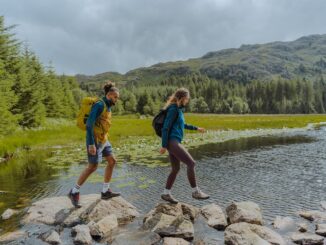
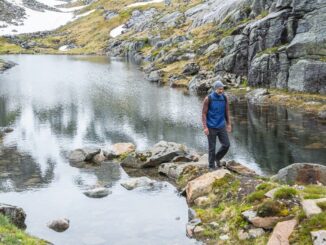
Be the first to comment